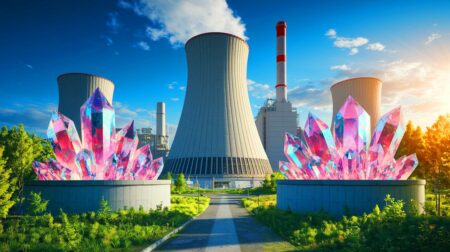| IN A NUTSHELL |
|
China’s ambitious leap into laser fusion research is capturing global attention, as satellite images reveal the construction of a massive research center in Mianyang. This facility is poised to outsize California’s renowned National Ignition Facility (NIF) by 50%, positioning China at the forefront of this cutting-edge technology. With potential implications for both civilian energy production and military applications, this development is sparking international debate. The fusion center’s construction underlines China’s strategic move to advance its capabilities in nuclear fusion, a field that promises not only clean energy but also raises concerns over enhanced nuclear weaponry.
China: A New Leader in Laser Fusion?
China’s determination to lead in laser fusion technology is evident with its latest project in Mianyang. Analysts, including those at Reuters, highlight that this facility will be 50% larger than the NIF, enabling more expansive and advanced research capabilities. By leveraging existing technologies, China is setting a course to not just participate but excel in the global fusion race. This center is expected to become a cornerstone in laser fusion research, integrating state-of-the-art technology to enhance our understanding of fusion processes.
While the primary goal of this research is to harness clean energy, the potential military applications cannot be ignored, making this a project of significant strategic interest. The implications of China’s advancements extend beyond energy, touching on national security and international power dynamics. As the nation moves forward, its ability to influence global fusion research and technology grows, possibly reshaping the scientific landscape.
Technology and Military Implications
The Mianyang facility will feature laser bays and a target chamber, essential components for hydrogen isotope fusion. According to Decker Eveleth from CNA Corp, these installations could dual-function for civilian and military purposes. The possibility of developing advanced nuclear weapons is a major concern internationally, as laser fusion technology allows for detailed simulations of thermonuclear processes, thus reducing the need for full-scale nuclear tests.
The advancement of this technology could disrupt the current nuclear power balance, making weapons more sophisticated and potentially harder to counteract. This dual-use nature of laser fusion underscores the strategic importance of such research, as nations strive to maintain or gain an edge in global military capabilities. The international community remains vigilant, aware that such technological advancements can alter geopolitical dynamics significantly.
Comparison with the National Ignition Facility
The NIF is renowned for its ability to focus 192 laser beams on a tiny target within fractions of a second, achieving significant breakthroughs in fusion reactions. China aims to surpass this with its larger and potentially more advanced facility. The ambition to outdo the NIF not only reflects China’s commitment to becoming a global leader in laser fusion but also highlights the competitive nature of this technological domain.
By adopting cutting-edge technologies, the Chinese center could set new standards in laser fusion research. This ambition is a testament to China’s resolve to emerge as a dominant force in the field. While this rivalry could stimulate scientific progress, it also raises questions regarding the underlying military motives and the potential implications for international security.
Geopolitical and Scientific Repercussions
China’s rise in laser fusion technology is not without international ramifications. Major powers like the U.S., France, the UK, and Russia, who also possess fusion capabilities, may perceive this as a challenge to their technological supremacy. The geopolitical implications of this fusion race are intricate and multifaceted, potentially influencing global alliances and policy decisions.
Scientifically, this facility could expedite nuclear fusion research, paving the way for sustainable energy solutions. Yet, the shadow of military applications looms large, with the international community closely monitoring these developments. As China bolsters its technological prowess, it may also shape global energy policies and alter the balance of power within the energy sector.
As China advances its ambitious laser fusion research center, the world watches with heightened interest. This technological leap could redefine both scientific research and global military dynamics. In this landscape of rapid advancement and competition, how will other nations respond to China’s burgeoning technological capabilities, and what strategies will they adopt to maintain their own positions on the global stage?
Did you like it? 4.4/5 (24)









Wow, this is like something out of a sci-fi movie! 🚀
Isn’t this a bit concerning for global security? 🤔
How long until this facility is fully operational?
China is really pushing boundaries! But at what cost?
Can we trust satellite images? They might be exaggerated.
Thank you for the detailed article! Very informative.
I’m curious how other countries will respond. New arms race?
What’s the environmental impact of such a massive project?
Hope this leads to cleaner energy and not more weapons! 🌍
Isn’t fusion still too theoretical for practical use?
This could be a game changer in the energy sector!
Do we have any more details on the technology being used?
Sounds like a tech marvel! But also a military threat. 😬
How does this compare to other fusion projects globally?
Will this affect international treaties on nuclear weapons?
Interesting article, but aren’t we jumping the gun a bit?
How much is the estimated cost of this facility?
Are there any international collaborations involved?
What’s the timeline for construction? Seems incredibly fast! 🏗️
Hope this is more about energy than weaponry.
Is there any way to monitor the dual-use capabilities? 🤨
Why is the focus more on military than energy benefits?
China is unstoppable at this point! 😮
How do we ensure this tech isn’t used for harm?
Thanks for highlighting the scientific aspects over military!
Isn’t the NIF still the leader in this field?
Will the public get access to any findings from this research?
Is there any international oversight on this project?
Lazer fusion sounds like a superhero power! 🦸♂️
The race for fusion energy is heating up!
How can other nations compete with this scale?
China going full speed ahead, but are there brakes? 😉